USS MULLINNIX DD-944
25 June 1972
Mullinnix Hit by Typhoon Ora
(While in Subic Bay)

My life on the Mullinnix I remember in terms of images, smells, and sounds rather than historical events. Gun mounts and the smell of spent powder; bug juice; salt air; the low rumble and steady vibration of the turning screws; the smell of JP5 - that had obviously been created as a cinematic tribute to my youth – and typhoons!
Navy Intelligence – now there’s a military oxymoron for you – warned of an approaching storm – Typhoon Ora. Between Mullinnix and Subic Bay there lay about a thousand miles of open ocean, enabling the ambitious early-season Pacific storm to take a serious run at the ship and Subic Bay Naval Base. The sky was looking more ominous, with black smoky clouds racing across the face of the moon.
“Set the special sea and anchor detail”, belched the IMC.
I awoke with a groan, and twisted around to get more comfortable. Some of these racks were as unforgiving as a nun with a ruler. What the hell? We were supposed to be in Subic until 1 July.
“Make preparations for getting under way.”
Giving up, I dragged my butt up to the aft head for a quick wiz. Looking out the hatch on the port side, I saw broiling darkness that seemed to be waiting on the horizon. Us from the Midwest could smell rain. I thought, “this ain’t going to be good.” The sky leaked thunder.
As Mullinnix pulled away from the tender @ 0829 and headed towards buoy #19, thunderclouds moved across the sun and dropped her into shadow. I walked along the port side amidships black with near-darkness. The sky flashed brilliantly, backlighting the scattered ships. Then as the lightening faded, the clouds ripped open and disgorged the rain. The wind whipping the signal flags caused shadows to slide across SM3 Stan “Stash” Stockham’s face, like water running down the bridge’s storm windows. Waves rolled relentlessly toward the ship.
Once anchored to buoy #19, The heavy drops fell thick and heavy as stones upon the decks, the noise like a distant roar of a wild beast. The sea heaved uneasily, deep blue as an old watch cap, dimpled by rain from the low steel clouds. The wind-driven rain was drowning the beds of hibiscus, banana trees, and hydrangeas, pooling in Po City’s street brickwork – all hidden behind the grizzled veils of rain.
The rain spattered on my glasses. I found a dry spot topside on the 01 deck behind the second stack and plopped down, protected from the spray of rain flying past me on both sides. I fired up a Marlboro with my Mux Zippo, watching the bay turning a color of glassy iron. A vast swell began to move vertically, like the rocking of the sea’s cradle. I then realized I was nothing but a thumbprint on a window of a skyscraper or a smudge of excrement on a tissue surging out to sea with a ton of sewage.
By the time I’d finished my smoke, near-gale-force winds and heavy seas were hitting Mullinnix broadside. Many may think, “the roar of the sea” is just another tired sea-story. NOT! The ship was rolling violently and it was difficult to hang on to the hand rails that were installed along the bulkheads. The water looked like a huge sheet of tin. One would see the immensity of the sea and look over a vast, water-world that could change from comrade to enemy in the matter of a few hours.
The rain reduced visibility to near zero. At 1230, Mullinnix turned on her aircraft warning lights. The typhoon had a sulfurous smell to it as swirling clouds of rain and bolts of lightning spilled into the sky. Rain danced on the surface of the water. The sky was gray from horizon to horizon.
Light flashed, blindingly white, and seconds later the crack of thunder rumbled like distant guns. Mullinnix fought the typhoon to a draw until the midwatch. The rain stopped with the suddenness which is characteristic of the sea. One minute it was falling in a furious cascade, and the next it was over. Ora had gotten bored with Subic and was heading northwest towards mainland China. Let the Chinese deal with her.
An hour before sunrise the world was shades of charcoal and pearl, a few stars showing. You could see the dock lights and sodium security lights on the base. Morning broke sunny and clear, with a stiff breeze blowing from the south. By 1547 the next afternoon, Mullinnix was tied up to Pier 16. There WOULD be liberty tonight! Another night in the Disneyland for sailors known simply as “Po City”!!!
__________
Typhoon Ora, known in the Philippines as Typhoon Konsing, was a Category 1 typhoon that left 131 people dead and $15 million (1972 USD, $68.4 million 2005 USD) in damage.
A tropical wave embedded in a trough formed on June 20 and moved westward without development. By June 23, the disturbance had strengthened, and became Tropical Storm Ora about 330 miles east of the Philippines.
Although poorly organized, Ora continued strengthening, becoming a Category 1 typhoon before encountering a high pressure system.
The area of high pressure forced the storm to make landfall on Luzon on June 25, emerging over the South China Sea later that day. Ora then continued its northwest track, turning northeast near Hainan Island and making landfall in southern China as a tropical storm. Ora then weakened and dissipated after moving inland.
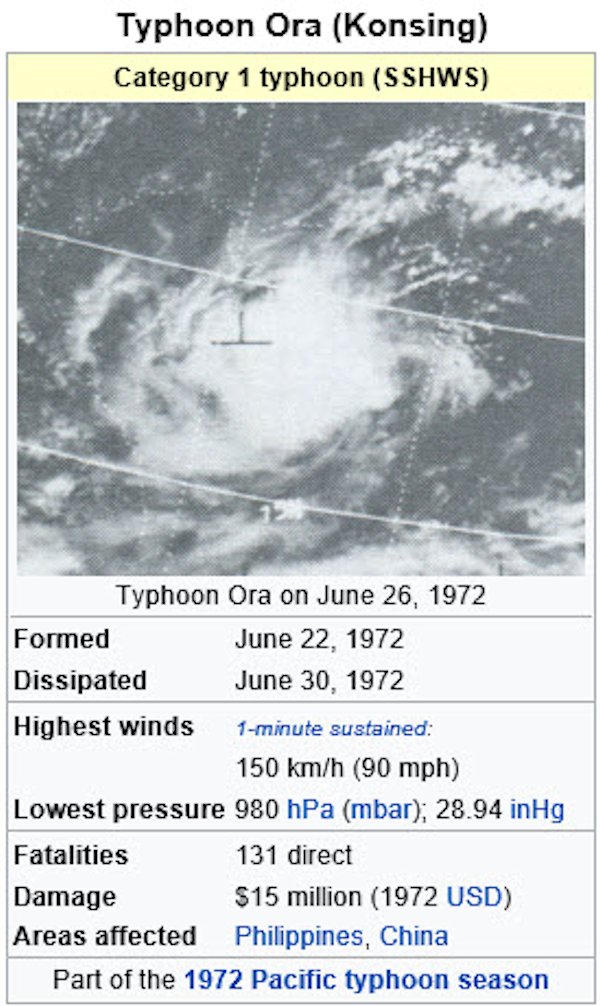
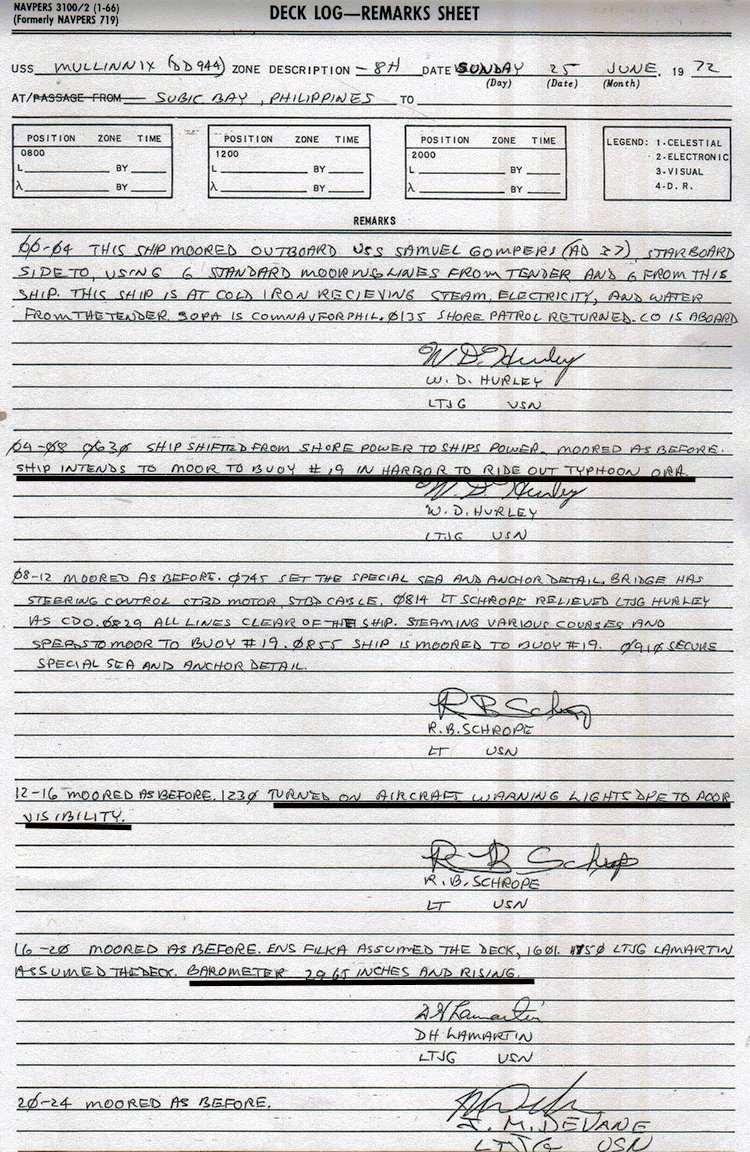
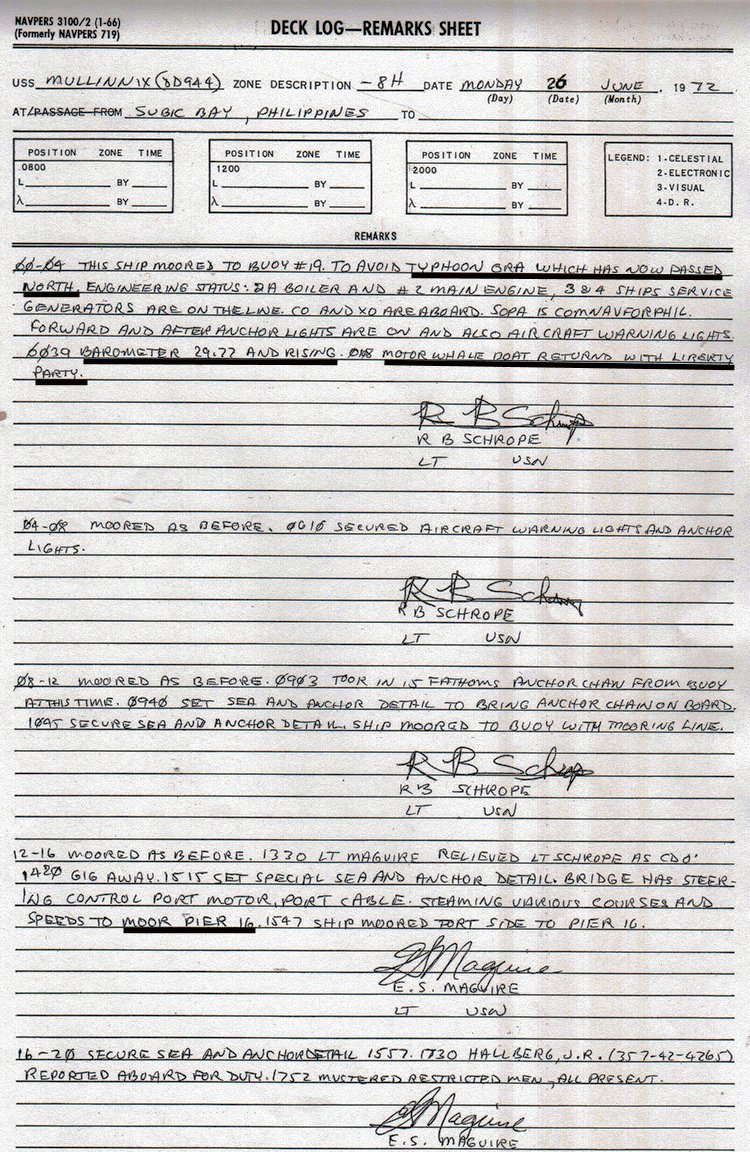
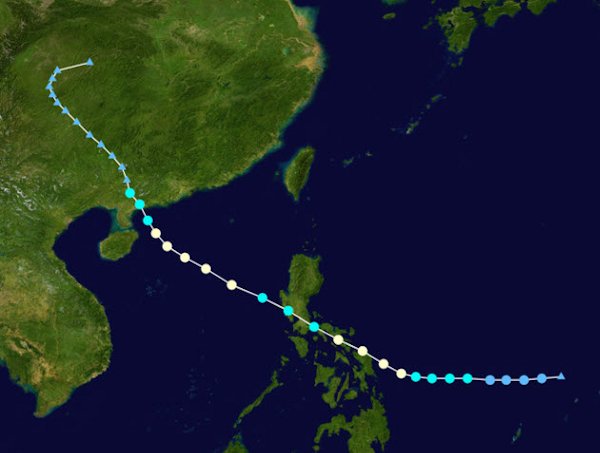
Track and Intensity of Ora, According to the Saffir–Simpson Scale
Ora made landfall in the Philippines and again in southern China. The first landfall brought 115 mph gusts and 9.3 inches (236.2 mm) of rain in a 24-hour period to Luzon. Flashfloods from Ora damaged homes and businesses, and the storm surge caused many ships offshore to run aground. A sailboat capsized near Rapu Rapu during the storm, causing one fatality. Three others were declared missing. In the Philippines, Ora caused 131 deaths, left almost 400,000 people homeless and left behind $15 million (1972 USD, $68.4 million 2005 USD) worth of damage.
Oras second landfall was in southeastern China as a tropical storm on June 27, however deaths or damage during that landfall was unavailable.
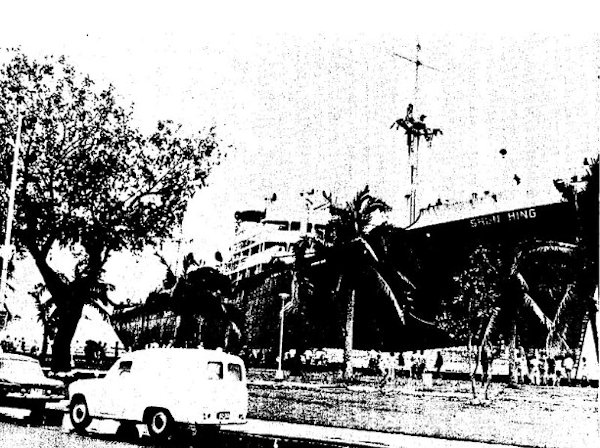
Ship Run Aground by Tyhpoon Ora
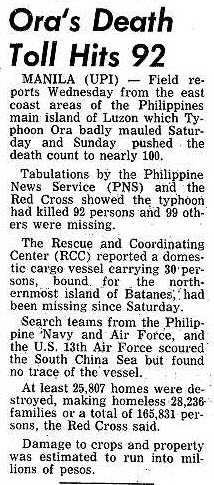
Stars and Stripes, 30 June 1972, p28
Go to 7 July "Counter Battery"
Back to 19 June "Norfolk Hears About Mullinnix"
Back to 1972 Vietnam Gunline - Page 1
Back to Ship History
Home
© 2019 by Frank Wood, All rights reserved







